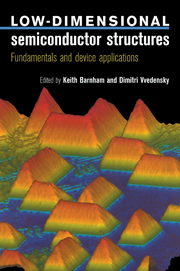Book contents
- Frontmatter
- Contents
- List of contributors
- Preface
- 1 Epitaxial Growth of Semiconductors
- 2 Electrons in Quantum Semiconductor Structures: An Introduction
- 3 Electrons in Quantum Semiconductors Structures: More Advanced Systems and Methods
- 4 Phonons in Low-dimensional Semiconductor Structures
- 5 Localization and Quantum Transport
- 6 Electronic States and Optical Properties of Quantum Wells
- 7 Non-Linear Optics in Low-dimensional Semiconductors
- 8 Semiconductor Lasers
- 9 Mesoscopic Devices
- 10 High-speed Heterostructure Devices
- Solutions to Selected Exercises
- Index
3 - Electrons in Quantum Semiconductors Structures: More Advanced Systems and Methods
Published online by Cambridge University Press: 06 July 2010
- Frontmatter
- Contents
- List of contributors
- Preface
- 1 Epitaxial Growth of Semiconductors
- 2 Electrons in Quantum Semiconductor Structures: An Introduction
- 3 Electrons in Quantum Semiconductors Structures: More Advanced Systems and Methods
- 4 Phonons in Low-dimensional Semiconductor Structures
- 5 Localization and Quantum Transport
- 6 Electronic States and Optical Properties of Quantum Wells
- 7 Non-Linear Optics in Low-dimensional Semiconductors
- 8 Semiconductor Lasers
- 9 Mesoscopic Devices
- 10 High-speed Heterostructure Devices
- Solutions to Selected Exercises
- Index
Summary
Introduction
In Chapter 2, low-dimensional systems were discussed in terms of a single-electron picture, and the behaviour of an electron was examined in the case that it is acted on by various potentials in semiconductors. Those potentials have been supposed to be externally imposed, for instance by a discontinuity in the band gap at an interface between two materials. But an electron will also feel the effect of other electrons in the system in which it finds itself.
There are circumstances in which these many-electron effects can be ignored, for example, in an undoped semiconductor with very few free charges. But in many cases, effects due to the presence of other electrons can be extremely important. Some of the most interesting low-dimensional systems involve many charges: there can be many free electrons, and there will often be in addition some distribution of fixed charges (space charge). To study such systems properly, we must discuss how to take into account the presence of such charges. The problem is one of self-consistency because we are trying to predict the behaviour of electrons (or holes), while that behaviour will itself depend upon those charges whose behaviour we are trying to predict: in other words, the problem itself depends upon the solution to the problem.
Many-body Effects
The Hartree Approximation
Consider the reaction of conduction electrons to the presence of a potential well V0(z) (we suppose this to be an externally determined well, e.g. a finite square well, which restricts electrons into a two-dimensional region).
- Type
- Chapter
- Information
- Low-Dimensional Semiconductor StructuresFundamentals and Device Applications, pp. 79 - 122Publisher: Cambridge University PressPrint publication year: 2001



